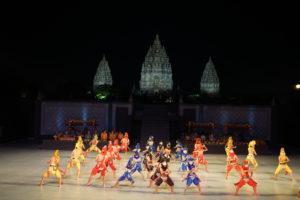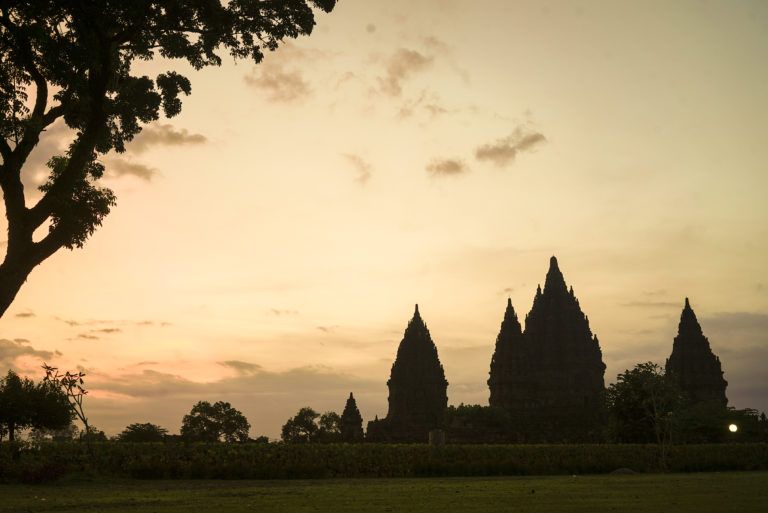History
Built on the ninth Century, Prambanan Temple is the largest Hindu temple complex in Indonesia. The first mention of Prambanan was in the Syiwagrha Inscription (856AD). With three main temples for the Trimurti; Shiva the destroyer of the universe, Vishnu the keeper of the universe, and Brahma the creator of the universe. Back in the glory days of the old Mataram Kingdom, Prambanan is used as a Candi Agung for various royal and religious ceremonies.
The high structures are typical of Hindu architecture, and the plan of the temple complex is a Mandala, as is Borobudur. As a symbol of the Hindu cosmos, the temple is vertically divided into three parts, both vertically and in plan. The three part is divided into Jaba/Bhurloka, Tengahan/Bhuvarloka, and Njeron/Svarloka.
At the Garbagriha (innermost sanctum) of this temple sits a three meters statue of Shiva. Prambanan as a Hindu Temple was made High and slim compared to Borobudur, with the main Shiva shrine stands 47 meters in the middle of the complex surrounded with smaller temples. Prambanan has a bas-relief on the inner side of the gate around the three main shrine. The bas-relief tells the story about Ramayana and can be read from the east gate clockwise around the inner compound.
Bhurloka
The base of the temples, as well as the outer square is the underworld. It was a large space marked by a rectangular wall. This is a place for ordinary folk, mortals, both human and animal. This is the place where lust and desire are commonplace. It is an unholy area. Bhurloka is 390 square meters wide, it used to have stone walls surrounding it.
Bhuvarloka
The central body of the temples and the middle square of the complex, represents the ‘middle world’ the place for those who have left their worldly possessions. This is where people begin to see the light of truth. The middle world had four rows of 224 small individual shrines, where all shrines are identical. Bhuvarloka is 222 square meters wide and used to have stone walls. This compound consist of four levels, with the innermost level the highest. The first level has 68 small stupas divided into four rows. The second level has 60 stupas. The third level has 52 stupas, and the top level has 44 stupas. All stupas in this compound has the same size, 6 meters wide and 14 meters high. Almost all structure in the middle square is now in ruins.
Svarloka
The top of the temples and the innermost square represents the realm of the gods, the holiest zone, and is crowned. There are 16 temples that consist of 3 main temples: Brahma the Creator, Shiva the Destroyer, and Vishnu the Keeper. Shiva temple is the biggest and the tallest amongst all with 47.6m high, while Brahma and Vishnu are 33m high. In addition to the three main temples, there are three Wahana Temples, four Kelir Temples, two Apit Temples and four Patok Temples.
The Svarloka area is 110 square meters wide and 1,5 meters higher than the central area. This area is surrounded with stone walls, with four Gapura Paduraksa on four sides, only the southern gate is still in its original state. In front of the gate is a small square stupas 4 meters high.
There are three main temples dedicated to the trimurti. Across the trimurti temples are the Wahana (vehicle) temples. Each temple is named after the vehicle of the gods. Garuda temple is across Vishnu, Nandi (ox) temple is the vehicle for Shiva, and Angsa (swan) temple for Brahma.
Ramayana Ballet
Introduction
Prabu Janaka, The king of Mantili Kingdom had a princess named Dewi Shinta. A competition is conducted in order to decide who will marry Dewi Shinta. The prince of Ayodya Kingdom , Raden Rama Wijaya, wins the competition.
Prabu Rahwana the ruler of Alengkadiraja Kingdom, is also eager to marry Dewi Widowati. He assumes that Dewi Shinta is the incarnation of Dewi Widowati whom he wanted for a long time.
Dandaka Forest.
Rama and Shinta accompanied by his younger brother Lakshmana are strolling in the Dandaka forest. But Rahwana saw Shinta and is eager to have her. Rahwana order one of his followers to change himself in to a golden deer called Kijang Kencana to attract Shinta. Interested in the beauty of the deer. Shinta asked Rama to capture the deer for her. Rama leaves Shinta and starts hunting the deer. After waiting for a long time, Shinta becomes nervous. She asked Lakshmana to look for Rama. Before leaving Shinta, Lakshmana drew a magic circle on the ground to protect her from danger. Rahwana noticed that Shinta is alone, he then tried to kidnap her but failed because of the magic circle. He then changed into an old beggar. When Shinta came out from the magic circle to give aims to the beggar, he took her and fled to Alengka Kingdom.
Running After The Deer.
Rama shot the deer with his magic arrow, but the deer transform into a giant ( Marica ). A battle breaks between Rama and Marica. Rama shot Marica with his arrow. Later on Lakshmana arrived and ask Rama to go back to Shinta’s place.
The Kidnap of Shinta
On the way to Alengka, Rahwana met a bird named Jatayu. After noticing that Shinta is the princess of Prabu Janaka. Jatayu attcaked Rahwana in order to free her but he is defeated by Rahwana. Meanwhile Rama found out that Shinta is gone. Later on they met the wounded Jatayu. Rama thought that Jatayu kidnapped Shinta. Rama tried to kill him but Leksmana prevents him. Jatayu then explained what happened and he died eventually. A moment later, a white monkey named Hanoman arrived. He was delegated by his uncle Sugriwa to look for two heroes who can kill Subali. Subali is sacred man and has taken Dewi Tara, Sugriwa’s beloved women. Rama then decided to help Sugriwa.
Kiskendo Cave
Sugriwa arrived in Kiskendo Cave with the help of Rama. Sugriwa defeats Subali and took Dewi Tara from him. Sugriwa decided to help Rama to look for Shinta. Sugriwa then sent Hanuman as an envoy to Alengka Kingdom.
Argasoka Garden.
Rahwana’s niece, Trijata is comforting Shinta in the garden. Rahwana asked Shinta to be his wife. Shinta refused, Rahwana is getting angry and wanted to kill her but Trijata prevent him to do so. Shinta suddenly heard a beautiful song sung by Hanuman, the white monkey. Hanuman told Shinta that Rama sent him to help her. Hanuman then destroyed the Alengka garden. Indrajid, Rahawana’s son captured him, Kumbakarna tries prevent this, but he is thrown out of the kingdom. Hanuman is sentenced to be burnt alive. Hanuman with fire around his body burnt Alengka palace.
Rama’s Bridge
After delegating Hanuman, Rama and his monkey army made a bridge to Alengka. When the bridge is finished, Hanuman returned and explained Alengka’s power. Rama then commanded Hanuman , Hanggada, Hanila and Jambawan to lead the troops to attack Alengka.
The Total War
A big battle occured between Alengka’s giant army and Rama’s monkey army. In this battle Indrajid was killed by Leksmana. Kumbakarna the younger brother of Rahwana also died. After the death of Kumbakarna, Rahwana finally commanded the whole Alengka troops to face Rama. In the end Rahwana was killed by Rama’s arrow and Hanoman throwed Mount Sumawana to Rahwana.
The Meeting of Rama and Shinta
After the death of Rahwana, Shinta finally met Rama. Rama surprisingly rejected her as he considered she is not pure anymore. In order to prove her purity, Shinta burn herself. With the help of God of fire, Shinta is saved from the fire. This makes Rama happy and accepted Shinta again.
– for more details on Ramayana Ballet performance at Prambanan click here.

The Ramayana Epoch is present in Prambanan's Relief Wall

Ramayana Ballet

Ramayana Ballet

Hanuman's Monkey Army
Gallery








How to Get There
The nearest major cities are Yogyakarta, 17 kilometres to the south west and Solo about 40 kilometres to the north east. The main road connecting these two large cities passes right by Prambanan and this makes transport links very straightforward. The nearest actual town to Prambanan is Klaten, about 3 km to the north.
Both Solo and Yogyakarta had international airports. Yogyakarta International Airport is currently serving international flights from Singapore and Kuala Lumpur. While Solo Adi Soemarmo airport is serving flights from Kuala Lumpur.
From Tugu Yogyakarta Train Station / Malioboro
Taxis and car rentals are available around Malioboro and Tugu Yogyakarta train station. For public transportation option, Trans Jogja bus is available at mangkubumi bus stop in Malioboro. Use the 1A bus and stop at Prambanan bus stop. From there you can cross the road to reach the Temple.
Bus
Use the Trans Jogja bus lane 1A to get to Prambanan. Alternatively, you could use the inter province bus heading to Solo or Surabaya and stop in front of the Temple.
The Trans Jogja bus usually available around every 15 minutes or so depending on the traffic. While inter province bus only accessible from Giwangan Bus Station every hour.
From Yogyakarta International Airport
Public transport available around the airport to Yogyakarta city. You can find DAMRI Bus and Shuttle (SatelQu) around the airport. If you enjoy travelling by train, you can take Prameks and Airport train from Wojo Train Station.
If you choose to ride a car, there are taxi and online taxi that will take about 64km from the airport.
Private Vehicle
The Temple is located on the Solo - Yogya road at km 16. Yogya Solo road is a stretch of national road running from the center of Yogya to Solo. To get to this road you can head east in the Yogya outer ring road. Or follow the road eastward from Ambarrukmo Plaza. The temple is right on the edge of the road.
Where to Sleep
Ticket Information
One time entrance ticket per person
TWC Prambanan
- >10 years old: USD 25
- aged 3 to 10: USD 15
Ticket includes Rp 1.000 insurance premium
Ticket Packages
Prambanan – Borobudur
- >10 years old: USD 45
- aged 3 to 10: USD 27
Prambanan – Ratu Boko (with free shuttle services between two temples)
- >10 years old: USD 45
- aged 3 to 10: USD 27